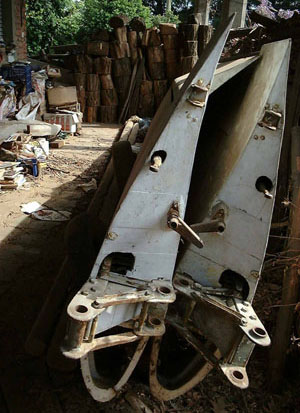
Restoration of URENDO
In spring 2001 I heard some friends of mine telling that an Urendo was still existing somewhere around Varese (about 50 Km North-West of Milano).
In fact I soon discovered that in a small country village called Somma Lombardo, by an old farm house, the Urendo marked I-AVMI, the first prototype with flaps, was sleeping there among a mountain of junk.
It must have been there, almost forgotten, for over thirty years judging from the thickness of the dust. Nobody knew how that Urendo was "landed" there. The farmer himself did not know who was the official owner of the sailplane as its documents were missing. After a few visits to inspect the sailplane and discuss with the farmer, we agreed to come back and pick it up under the promise that we would have restored it. We borrowed a trailer from the Varese Gliding Club and finally we went to collect the Urendo .
I soon invited Werner Roth, a VGC member, to have a look to my finding and he made encouraging comments about it. Werner has a great experience in restoring vintage sailplanes and he offered his help in that project. To start with, he brought home in Switzerland the rudder and the elevator, plus the broken seats and a number of metal parts.

01

02 - Cunati Biasci Zorzoli

03

04
Still the amount of work for one person only was really to much and additionally
I have experience only in model building, so I started worrying not to
be able to complete the restoration work only by myself. Luckily Lino
del Pio, a retired surgeon with a long experience in aeronautical works,
offered to help me to restore the Urendo, so we moved the sailplane into
his workshop in Arluno (20Km west of Milano). Incidentally Lino knew the
Urendo for long time as he flew with it in the early sixties.
Before starting any restoration work, we had to take care of all bureaucratic matters such as to find out all documents of the machine, to identify the owner if any, and even more important to find out whether the sailplane was still registered by the Italian Civil Aviation Agency or it was for some reasons struck off the aviation register. Luckily we could find all papers by Edgardo Ciani, the designer of the Urendo, we traced the owner of the machine and finally the evidence that it was not struck off the aviation register.
At this point we could start finally our restoration project and we agreed to spend one day per week to work for it. At first we removed the old fabric from the fuselage and tail planes and took apart all metal parts. The metal structure of the fuselage appeared in good shape despite some marginal rust and after a reasonable number of hours the whole body was ready to be painted. The fuselage looked really new and now it was put aside waiting for a new coverage. As second work we started removing the old painting from the wings. The wings of the Urendo are covered both sides with plywood and to remove the old painting was quite a job which took a great amount of time. Once the cream colour was totally gone, we could clearly identify some spots where a repair was needed, but actually in a very limited area. Before repairing we could inspect the inside of the wing and realise that the wing was in perfect conditions
At this point, with the help of some friends we tried to put the whole thing together and this operation was quite satisfactory.

06

08

09

10 - Del Pio Martignoni Zorzoli

12

13 - The Authors

14 - Lino testing
Done! Much faster was this operation for the tail planes. Now the machine was ready for painting and we got from a friend several gallon of white paint. That was easy and we had some fun doing it. We worked then on the cockpit, fixing the seats and the wooden floor and the instrument panel. All controls cables were fixed and tested. We were getting close to the final stage: the Certification by the Civil Aviation Body.
We brought the Urendo with a newly purchased trailer by a certification company, which controlled all our works, made few improvements and then called the inspector. On June 2006 the Urendo made the first flying test and received the flying certificate.
Looking back, we realised that the restoration work took about four years, but the result has been paying for the efforts

15 - Urendo finally flying

16 - Urendo flying


